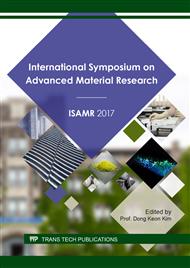[1]
R. R. Thomas, D. R. Anton, W. F. Graham, M. J. Darmon, B. B. Sauer, K. M. Stika et al, Preparation and surface properties of acrylic poly- mers containing fluorinated monomers, Macromol. 30(10) (1997) 2883- 2890.
DOI: 10.1021/ma9618686
Google Scholar
[2]
J. Y. Liang, L. He, Y. S. Zheng, Synthesis and property investigation of three core-shell fluoroacrylate copolymer latexes, J. Appl. Polym. Sci. 112(3) (2009) 1615-1621.
DOI: 10.1002/app.29577
Google Scholar
[3]
K. Honda, M. Morita, O. Sakata, S. Sasaki, A. Takahara, Effect of surface molecular aggregation state and surface molecular motion on wetting behavior of water on poly(fluoroalkyl methacrylate) thin films, Macromol. 43(1) (2010) 454-460.
DOI: 10.1021/ma901973t
Google Scholar
[4]
J. Q. Huang, W. D. Meng, F. L. Qing, Synthesis and repellent properties of vinylidene fluoride-containing polyacrylates, J. Fluor. Chem. 128(12) (2007) 1469-1477.
DOI: 10.1016/j.jfluchem.2007.08.005
Google Scholar
[5]
T. T. Yang, L. Yao, H. Peng, S. Y. Cheng, I. J. Park, Characterization of a low-wettable surface based on perfluoroalkyl acrylate copolymers, J. Fluor. Chem. 127(8) (2006) 1105-1110.
DOI: 10.1016/j.jfluchem.2006.05.019
Google Scholar
[6]
R. N. Wenzel, Resistance of solid surfaces to wetting by water, Ind. Eng. Chem. Res. 28(8) (1936) 988-994.
DOI: 10.1021/ie50320a024
Google Scholar
[7]
A. B. D. Cassie, S. Baxter, Wettability of porous surfaces, Trans. Faraday Soc. 40 (1944) 546-551.
DOI: 10.1039/tf9444000546
Google Scholar
[8]
L. C. Gao, T. J. McCarthy, How Wenzel and Cassie were wrong, Langmuir 23(7) (2007) 3762-3765.
DOI: 10.1021/la062634a
Google Scholar
[9]
W. Li, Y. P. Diao, S. Y. Wang, G. P. Fang, G. C. Wang, X. J. Dong, New roughness parameter for the characterization of regularly textured or ordered patterned superhydrophobic surfaces, Langmuir. 25(11) (2009) 6076-6080.
DOI: 10.1021/la901073w
Google Scholar
[10]
J. W. Ha, I. J. Park, D. K. Kim, J. H. Kim, S. B. Lee, Surface properties of core-shell particles containing perfluoroalkyl acrylate in shell, Surf. Sci. 532-535 (2003) 328-333.
DOI: 10.1016/s0039-6028(03)00463-1
Google Scholar
[11]
M. W. Daniels, L. F. Francis, Silane adsorption behavior, micro- structure, and properties of glycidoxypropyltrimethoxysilane- modified colloidal silica coatings, J. Colloid Interface Sci. 205(1) (1998) 191-200.
DOI: 10.1006/jcis.1998.5671
Google Scholar
[12]
F. Caruso, M. Spasova, A. Susha, M. Giersig, R. A. Caruso, Magnetic nanocomposite particles and hollow spheres constructed by a sequential layering approach, Chem. Mater. 13(1) (2000) 109-116.
DOI: 10.1021/cm001164h
Google Scholar
[13]
K. Zheng, L. Chen, Y. Li, P. Cui, Preparation and thermal properties of silica-graft acrylonitrile-butadiene-styrene nanocomposites, Polym. Eng. Sci. 44 (2004) 1077-1082.
DOI: 10.1002/pen.20100
Google Scholar


